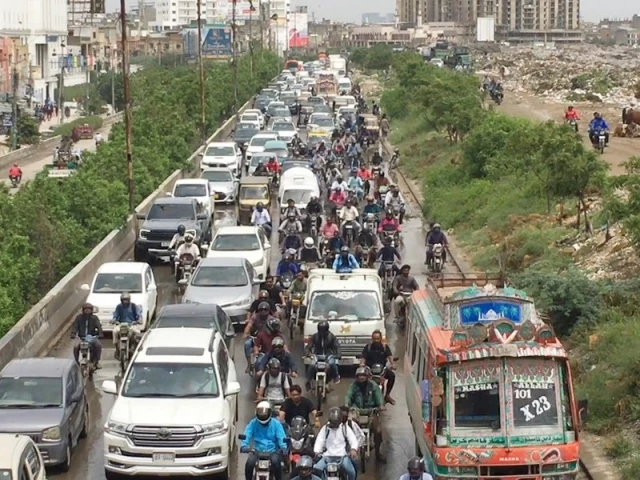Health experts urge prevention over treatment as cases of slipped discs, sciatica on the rise
Traffic jam from Baloch Colony Expressway to Qayyumabad Chowrangi in Karachi on Thursday. PHOTO: EXPRESS
For millions of Karachiites, motorbikes remain the most affordable and efficient form of transport, but health experts say the city’s dilapidated infrastructure and battered roads, riddled with potholes and uneven patches, are causing serious back injuries to motorcyclists.
It was 2023 when Tariq, a 37-year-old employee of the sports department at Sir Syed University, felt a sudden pain in his lower back. “The pain was unbearable, I couldn’t even ride my motorbike while returning home. A colleague had to drop me off,” recalls Tariq. An MRI later revealed nerve compression between his L4 and L5 vertebrae, which doctors warned could lead to chronic back problems if left untreated. “The doctor asked if I sat for long hours, but I told him I am a sportsman,” says Tariq. “That’s when he said the real reason was my daily motorcycle rides.”
Physiotherapist Dr. Faizan explains, “if someone cycles from North Karachi to Korangi or Gulshan-e-Hadeed daily, this attitude puts the rider under constant stress.” Furthermore, he notes, “Continuous jerking affects spinal alignment and muscle balance.” The doctor highlighted the city’s poor road conditions and neglected maintenance of the bike’s shock absorbers leading to the worsening situation.
Dr. Majid, another physical therapist, notes that many of the young patients who visit his clinic, suffering from back pain or slipped discs, are regular motorcycle commuters. “Frequent impingement mainly affects the lower lumbar region L4, L5, S1 and S2,” he mentioned. “The spine absorbs jolts, which in the long run lead to stiffness and chronic pain.”
According to the Pakistan Orthopedic Association (POA) and the World Health Organization (WHO), over 40 percent of adults in urban areas suffer from musculoskeletal pain. A 2022 study by Dow University also found that 60 percent of Karachi’s motorcyclists suffer from lower back pain.
Meanwhile, at Health Asia Expo 2025, a German product called ‘Spine Fitter’ was introduced in Pakistan. The device is silicone-based, designed to help align the spine and relieve tension with just 10 minutes of daily use. The ‘Spine Fitter’ works by using a unique shape with parallel balls to provide mechanical stimulus and deep pressure along both sides of the spine, helping to massage and loosen tense muscles and fascia.
A distribution manager for the product, Amjad, says, “This is the first time such a product has been launched in Pakistan and it is especially useful for people who sit or cycle for long hours.” Dr. However, Majid warns that the product is not suitable for everyone, saying: “It is effective for young users, but those over 50 should be careful as it may be difficult for them to lie down to exercise.”
Noting that physical exercise can potentially ease the pain, Tariq says it took him over a year and a half to recover with multiple physical therapy and chiropractic sessions. “I tried painkillers, oils and stretches, but eventually started playing badminton, which helped strengthen my back,” he says.
Similarly, 40-year-old Zahid Ahmed said he gave up cycling for a month after developing back pain and turned to football as a remedy. “In the beginning, the pain worsened, but regular exercise removed completely pain-free.”
Dr. However, Faizan emphasized prevention over treatment. He noted “before medicine or surgery, fix the cause”. Also, he said, the right solution is to “maintain your bike’s seat and shocks, and watch your posture.”



